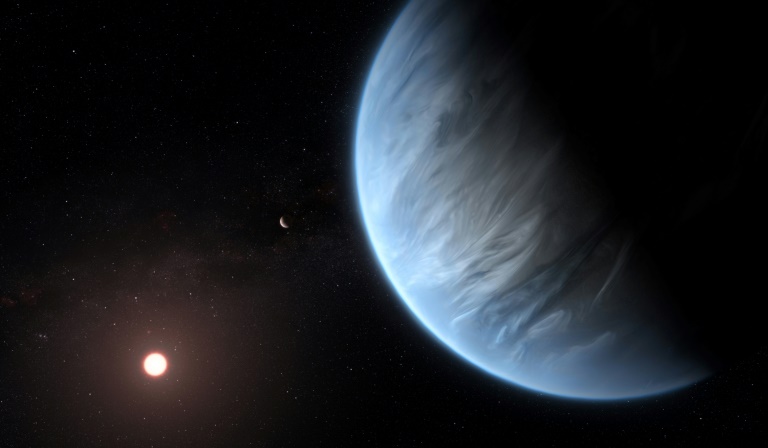Astronomers Discover Promising Signs of Life on Exoplanet K2-18b

Astronomers made a groundbreaking announcement on Thursday, revealing that they have detected the most promising hints of potential life on a planet situated beyond our solar system. However, the declaration has prompted a wave of skepticism among other scientists regarding the implications of these findings.
The planet in question, K2-18b, is located 124 light years away in the constellation of Leo. It has been the subject of intense scientific debate, particularly concerning whether it could be classified as an ocean world capable of supporting microbial life. A research team consisting of British and US scientists utilized the advanced capabilities of the James Webb Space Telescope to identify the presence of two specific chemicals in K2-18b's atmospheresignificant indicators known as "biosignatures" that could suggest the existence of extraterrestrial life.
The two chemicals detected, dimethyl sulfide (DMS) and dimethyl disulfide, are notable because they are produced exclusively by living organisms on Earth, primarily by microscopic marine algae known as phytoplankton. While these findings are exciting, the researchers have urged caution, emphasizing the necessity for additional observations to verify their results. They clarified that they are not claiming a definitive discovery of life but rather intriguing indications that warrant further exploration.
Dr. Nikku Madhusudhan, an astrophysicist at Cambridge University and the lead author of the study published in The Astrophysical Journal Letters, spoke at a press conference about the implications of their findings. He stated, What we are finding at this point are hints of possible biological activity outside the solar system. Frankly, I think this is the closest we have come to seeing a feature that we can attribute to life.
Despite these promising signals, skepticism remains prevalent among experts in the field. Some scientists highlighted previous disputes surrounding earlier discoveries about K2-18b, suggesting that the detected chemicals could have originated from unknown non-biological processes.
K2-18b is a particularly unique exoplanet, boasting a mass more than eight times that of Earth and a size 2.5 times larger. It orbits its star in what is referred to as the habitable or "Goldilocks" zone, an area where temperatures are just rightnot too hot and not too coldallowing for the existence of liquid water, which is widely regarded as essential for life.
The process of observing distant exoplanets involves monitoring them as they transit in front of their host stars, which enables astronomers to study how atmospheric molecules interact with the starlight. In 2023, the Webb telescope initially detected methane and carbon dioxide in K2-18b's atmosphere, marking the first observation of such carbon-based molecules in an exoplanet residing within a habitable zone. Following this, astronomers turned their attention back to K2-18b after the Webb telescope identified weak signals of DMS, utilizing its mid-infrared instrument to detect various wavelengths of light. The subsequent observations revealed much stronger signals of both chemicals, although they remained below the "five sigma" threshold that scientists typically seek to establish significant findings.
Even if these results are confirmed, it is important to note that this does not necessarily indicate that K2-18b is teeming with life. Previous studies found traces of DMS on a comet, suggesting that it could potentially be produced through non-organic means. Nevertheless, the concentration of DMS detected on K2-18b was reported to be thousands of times greater than levels found on Earth, which Madhusudhan argues implies a biological source for the chemical.
K2-18b has long been viewed as a leading candidate for classification as a "hycean planet," a term used to describe larger ocean worlds characterized by hydrogen-rich atmospheres. While these planets may not be expected to host intelligent extraterrestrial beings, they could be home to microorganisms reminiscent of early life forms found in Earth's oceans billions of years ago.
However, some research has raised concerns about whether the currently identified hycean planets, including K2-18b, are situated too close to their stars to sustain liquid water. K2-18b completes an orbit around its star every 33 days, leading some experts to argue that the planet may be excessively hot for life to exist. Professor Raymond Pierrehumbert of Oxford University has conducted independent research suggesting that, if K2-18b does contain water, it could be hellishly hot and therefore inhospitable, potentially resembling oceans of lava rather than habitable waters.
In light of the mixed reactions from the scientific community, Dr. Sara Seager, a professor of planetary science at MIT, called for patience and caution in interpreting the data. She reminded observers of past claims regarding water vapor in the atmosphere of K2-18b, which were later found to be attributable to a different gas altogether. Furthermore, she pointed out that within our solar system, celestial bodies such as Mars, Venus, and some of Saturns moons, like Enceladus, may hold a better chance of harboring life.
Looking ahead, Madhusudhan estimated that obtaining confirmation of their findings could require just an additional 16 to 24 hours of observing time with the Webb telescope. This confirmation could occur in the not-too-distant future. Beyond K2-18b, Madhusudhan expressed optimism that the Webb telescope and future observational instruments could enable humanity to identify signs of life beyond Earth sooner than anticipated. He concluded with a profound statement, saying, This could be the tipping point, where suddenly the fundamental question of whether were alone in the universe is one were capable of answering.
Copyright AFP 2024. All rights reserved.



























